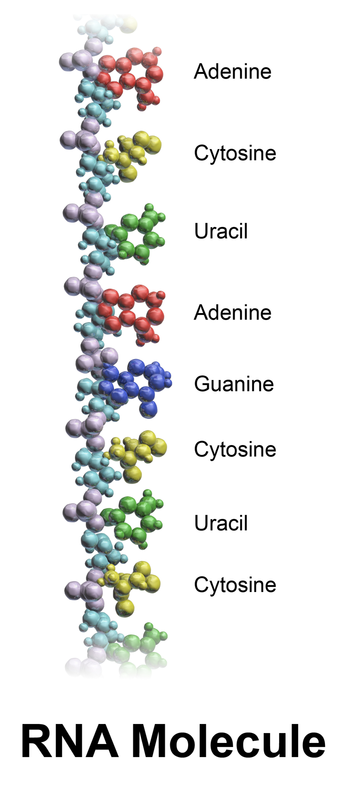


See if using lower-concentration or room-temperature alcohol changes your results. Try swishing with plain water to see how salt affects the experiment. Further Studyįor further study, experiment with different types of liquid soap. The strand of clumped together DNA would have eventually dissolved in the saltwater, but since it’s not soluble in alcohol, it precipitates out where the liquid layers meet. The rest of the cheek cells remained in the saltwater-soap solution. Gently mixing the soap and mouthwash solution ensured you didn’t break up the DNA clumps too much.

The degreasing agents in the soap worked to break down the cell membrane to release the DNA, which is housed inside the cell’s nucleus. When you swished the saltwater around in your mouth and scraped your teeth along the inside of your cheek, you were also collecting cheek cells.
#Dna stands for ribonucleic acid how to#
Proteins determine cell type and function, so a cell knows whether it is a skin cell, a blood cell, a bone cell, etc., and how to perform its duties.
#Dna stands for ribonucleic acid code#
Genes provide the code for the production of a protein and control hereditary characteristics, such as eye color or personality behaviors. These instructions are divided into segments along a strand of DNA and are called genes. Together, this grouping of a phosphate, sugar, and nitrogenous base makes up a subunit of DNA called a nucleotide, a sort of chemical building block.īut how can a molecule hold information? The base sequence determines the biological instructions that will be passed on through a DNA strand. The sides of the ladder, also called the backbone of the DNA molecule, is made from an alternating pattern of phosphate, sugar, then phosphate again. Adenine and thymine connect to each other and cytosine and guanine connect to each other. The rungs of DNA are made from four different types of nitrogen-containing bases paired together through hydrogen bonds: adenine (A), thymine (T), cytosine (C), and guanine (G). Sometimes DNA’s structure is described as a twisted ladder that scientists refer to as a “double helix.” It’s compared to a set of blueprints since it houses the biological instructions that tell an organism how to build cells and what role they’ll play. Passed from one generation of living organisms to the next through reproduction, DNA contains the blueprint for development, survival, and reproduction. Stored in the freezer, you can preserve your DNA almost indefinitely! What Happened:ĭNA stands for deoxyribonucleic acid (DNA) and it’s a molecule found in the nucleus of plant and animals cells. To save it, carefully scrape it into the small vial with a few drops of alcohol. Pipette (if alcohol doesn’t come in a dropper bottle)ġ0.Isopropyl or ethyl alcohol (at least 70% concentration, higher is better-we used 95%), chilled in freezer for several hours.Genes provide the code for the production of a protein and control hereditary characteristics such as eye color or personality behaviors. The instructions are divided into segments along a strand of DNA and are called genes.

It’s compared to a set of blueprints since it contains the instructions on how to build cells. Deoxyribonucleic acid (DNA) is a chemical found in the nucleus of cells that contains the blueprint for the development and function of living organisms.


 0 kommentar(er)
0 kommentar(er)
